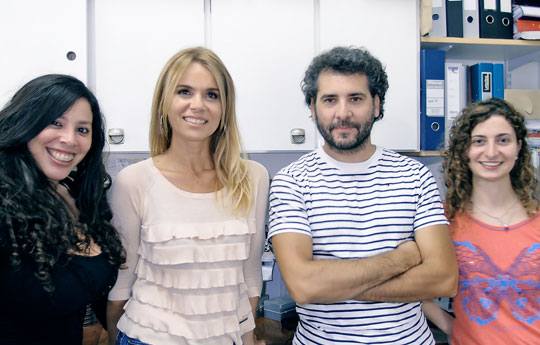In daily life, people are in permanent contact with a large number of bacteria. One of them is Pseudomonas aeruginosa, widely distributed in nature. Can be isolated from soil samples, pure and polluted waters, as well as plants, animals and even healthy people.
Due to its characteristics, this bacterium is of importance at a biotechnological level., but in turn implies an important health problem. Thus, a group of Cordovan scientists led by Andrea Smania, Independent researcher of CONICET at the Center for Research in Biological Chemistry of Córdoba (CIQUIBIC, CONICET-UNC), is dedicated to the study of adaptive mechanisms in this organism, particularly those related to controlling the mutation rate.
Now, in collaboration with a group of researchers led by Néstor Carrillo of the Institute of Molecular and Cellular Biology of Rosario (IBR, CONICET-UNR), take a new step toward understanding their survival strategies, which could lead to new therapies to fight diseases caused by this infectious agent.
In a recent study published in the journal PLOS Genetics, scientists identified a gene in the genome of Pseudomonas aeruginosa whose product contributes to the survival and virulence of this microorganism.
One in ten hospitals presents cases of opportunistic infections with this bacterium, affecting immunocompromised patients, especially those interned in intensive cancer therapy, HIV or burned. But there is a population group especially vulnerable to infections with Pseudomonas aeruginosa formed by cystic fibrosis sufferers, in which it constitutes the main cause of morbidity and death associated with this disease.
In fibrocystic lung and other pathological settings, the bacterium must face the oxidative attack of the host, and there is a correlation between virulence and the possibility of tolerating these oxidative assaults. On the other hand, Pseudomonas it is resistant to a large number of antibiotics belonging to different families, whose mechanisms of action in many cases are associated with the generation of oxidative stress.
Research focus
"The great flexibility of gene expression in Pseudomonas aeruginosa allows its survival in very varied environments and gives it a unique versatility within the microbial world. Understanding how these adaptive mechanisms work can allow us to block or reduce them., and thus develop potential treatments for the control of infections caused by this pathogen ”explains Smania.
By his side, Carrillo comments that the isolated gene codes for a protein called flavodoxin, that connects different metabolic pathways, and it has been systematically associated with antioxidant tolerance in many other microorganisms but which had not been identified in Pseudomonas.
And they explain, "It was found that the expression of flavodoxin in Pseudomonas aeruginosa increases under oxidative conditions, suggesting an antioxidant role. In fact, when bacteria that do not produce flavodoxin are obtained by genetic engineering methods - what is known as null mutants- we observe that they accumulate higher intracellular levels of oxidants and show less tolerance to the toxicity of hydrogen peroxide compared to the wild strain ”.
At the same time, the presence of flavodoxin in Pseudomona aeruginosa decreases death and mutability caused by oxidative damage, and contributes to the survival of this bacterium in cells of the immune system and in the fly infection model Drosophila melanogaster, which in turn increases the infection rate and insect mortality..
"Pseudomonas aeruginosa it has a highly conserved part of its genome and a smaller proportion, but significant, which is variable and different in each strain of this bacterium. The flavodoxin gene is located in this variable region of the genome, along with other genes linked to stress tolerance ", revels Smania.
Conclusion, the researcher highlights that the high conservation between strains, coupled with the presence of these strain-specific genes, could explain the ability of this bacterium to colonize such diverse niches, including the human body.
In a certain ecological niche, the entire bacterial population can exploit the genetic information of the species and, at the same time, each strain contains its own sequences that are a source of genetic variability, important in its evolution.
So, the results indicate that flavodoxin gives adaptive advantages to the bacteria, contributing to its survival in oxidative conditions and therefore to its virulence. Since flavodoxins are not present in animals, this gene constitutes a potential and interesting therapeutic target for the control of this relevant opportunistic pathogen.
- By Jimena Zoni. IBR.
- About Research.
- Alejandro J. Moyano. Research assistant. CIQUIBIC.
- Romina A. Tobar. Doctoral fellow. CIQUIBIC.
- Yanina S. Rizzi. Doctoral fellow. CIQUIBIC.
- Adriana R. Krapp. Lead professional. IBR.
- Juan A. he said. Pastor Institute.
- José Luis Bocco. Principal investigator. CIBICI.
- Maria-Carla Saleh. Pastor Institute.
- Nestor Carrillo. Senior researcher. IBR.
- Andrea M. Craving. Independent researcher. CIQUIBIC.
Photo (Carlos Mas): Romina Tobares, Andrea Smania, Alejandro Moyano and Yanina Rizzi.



